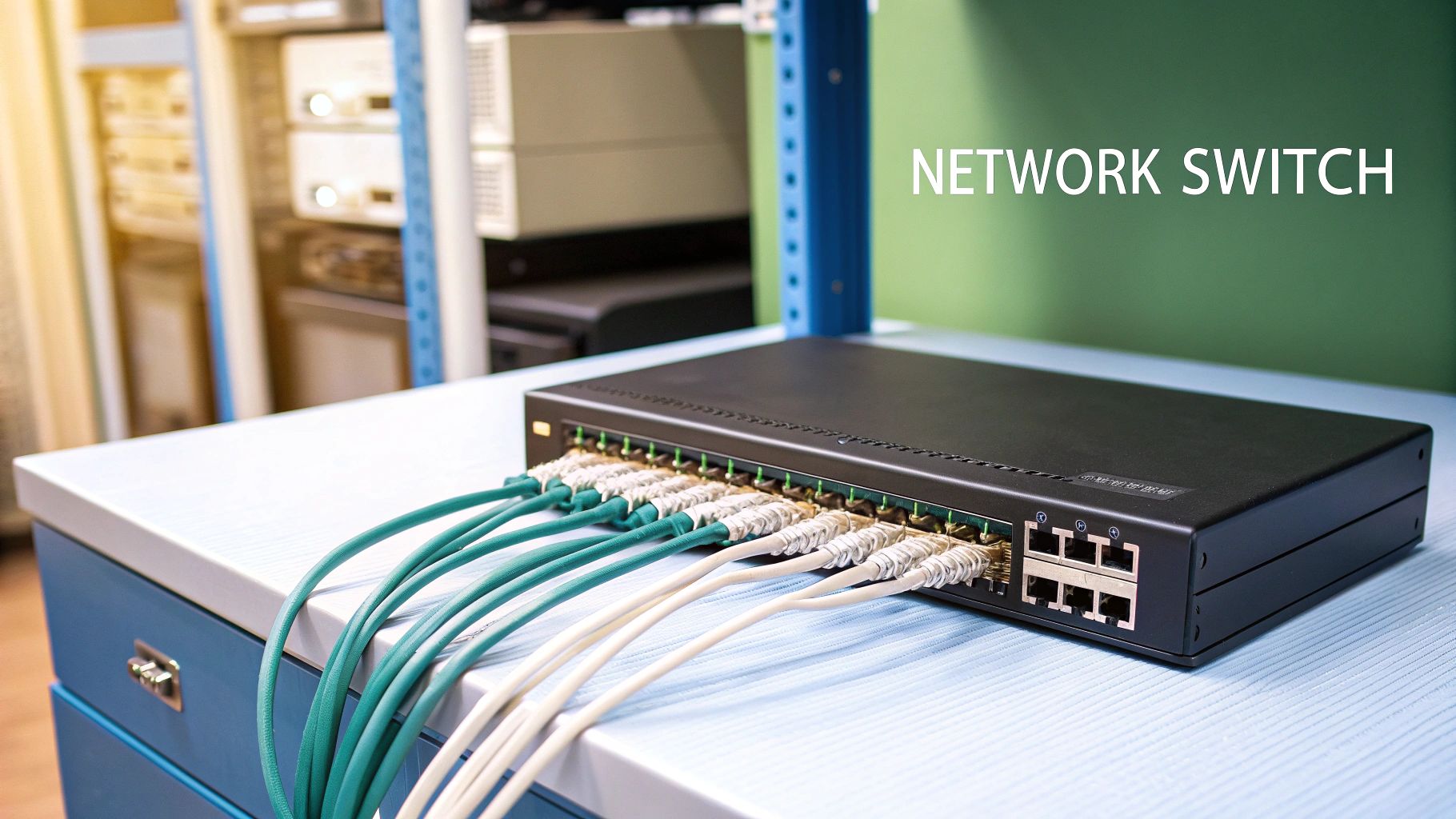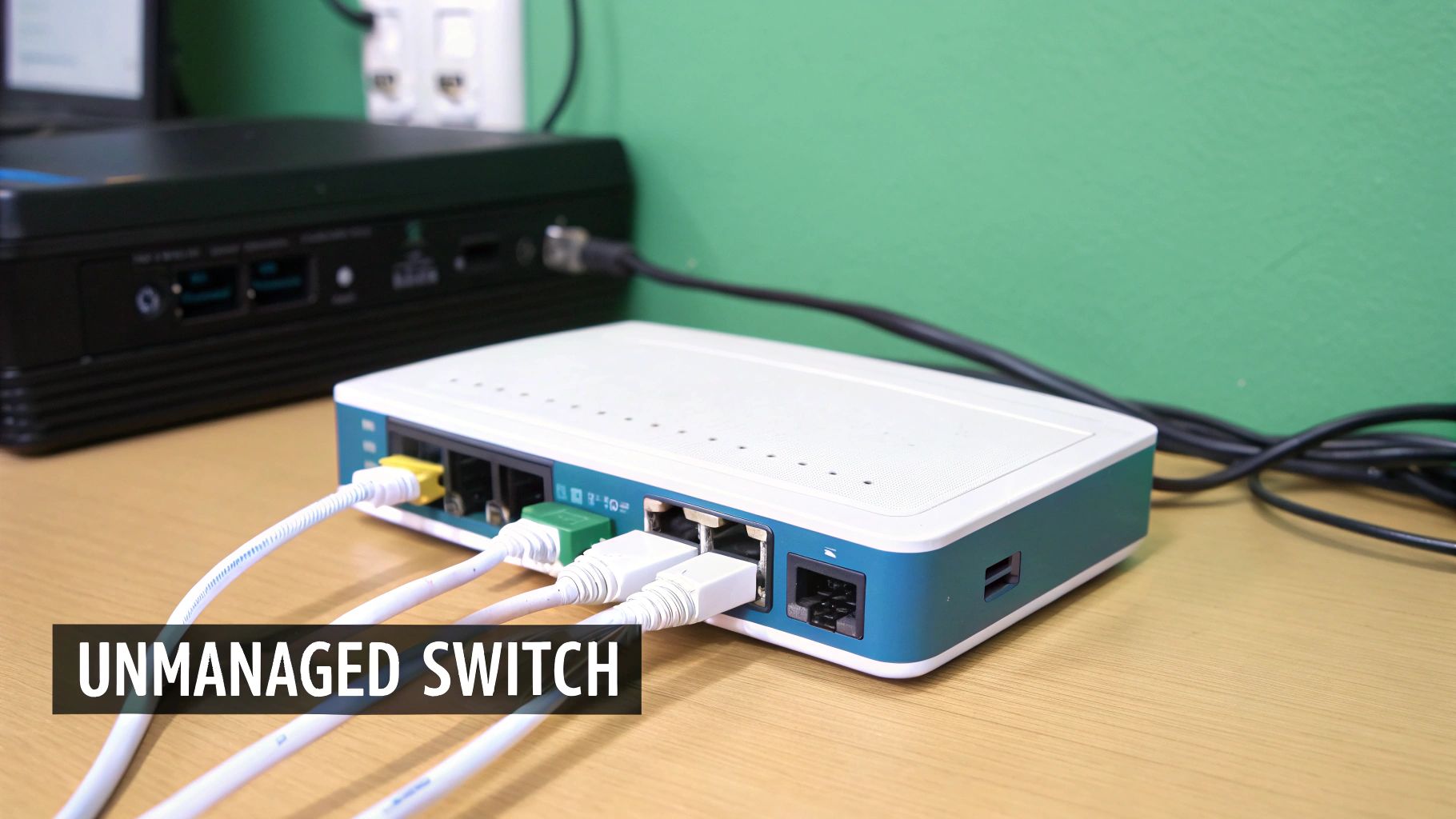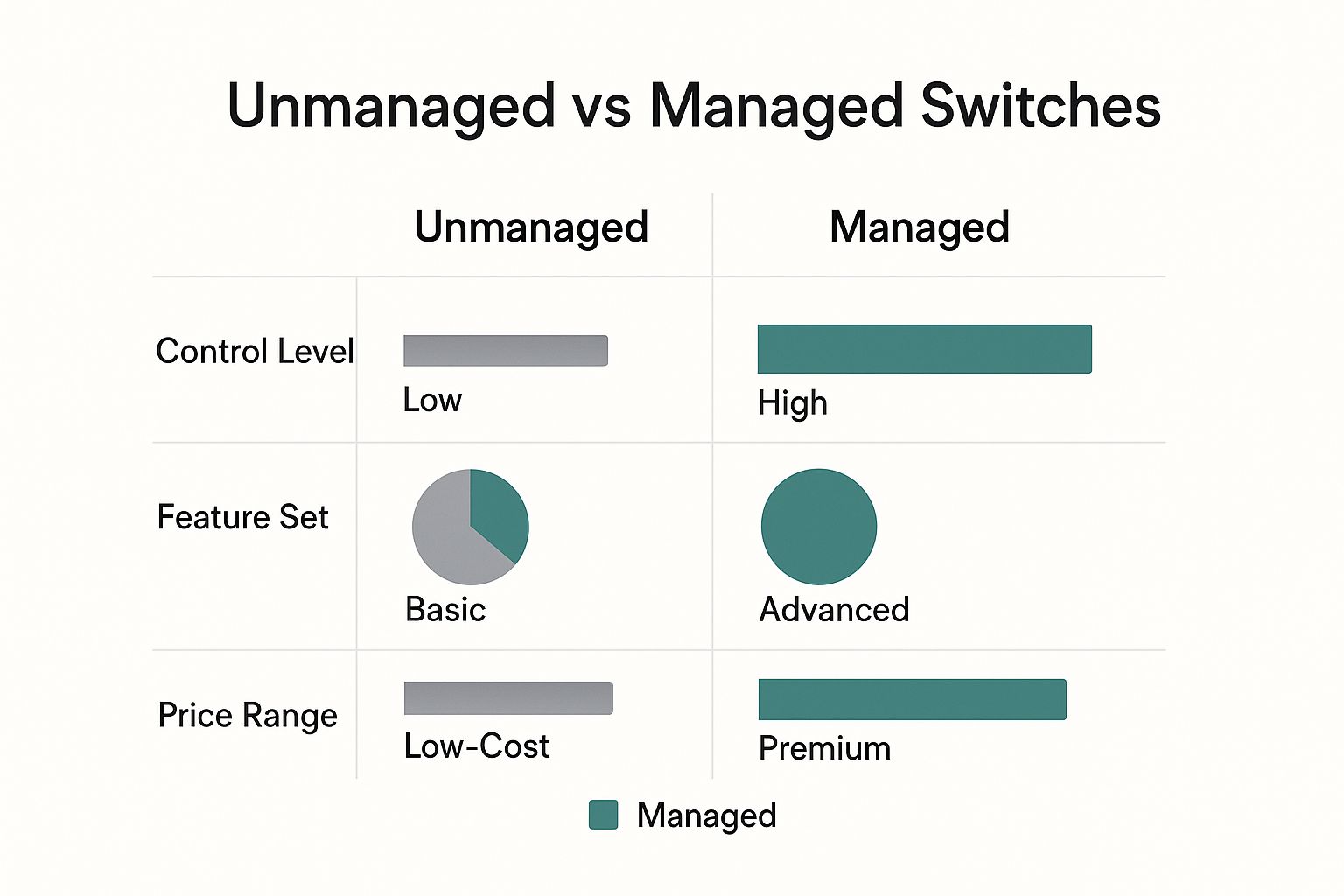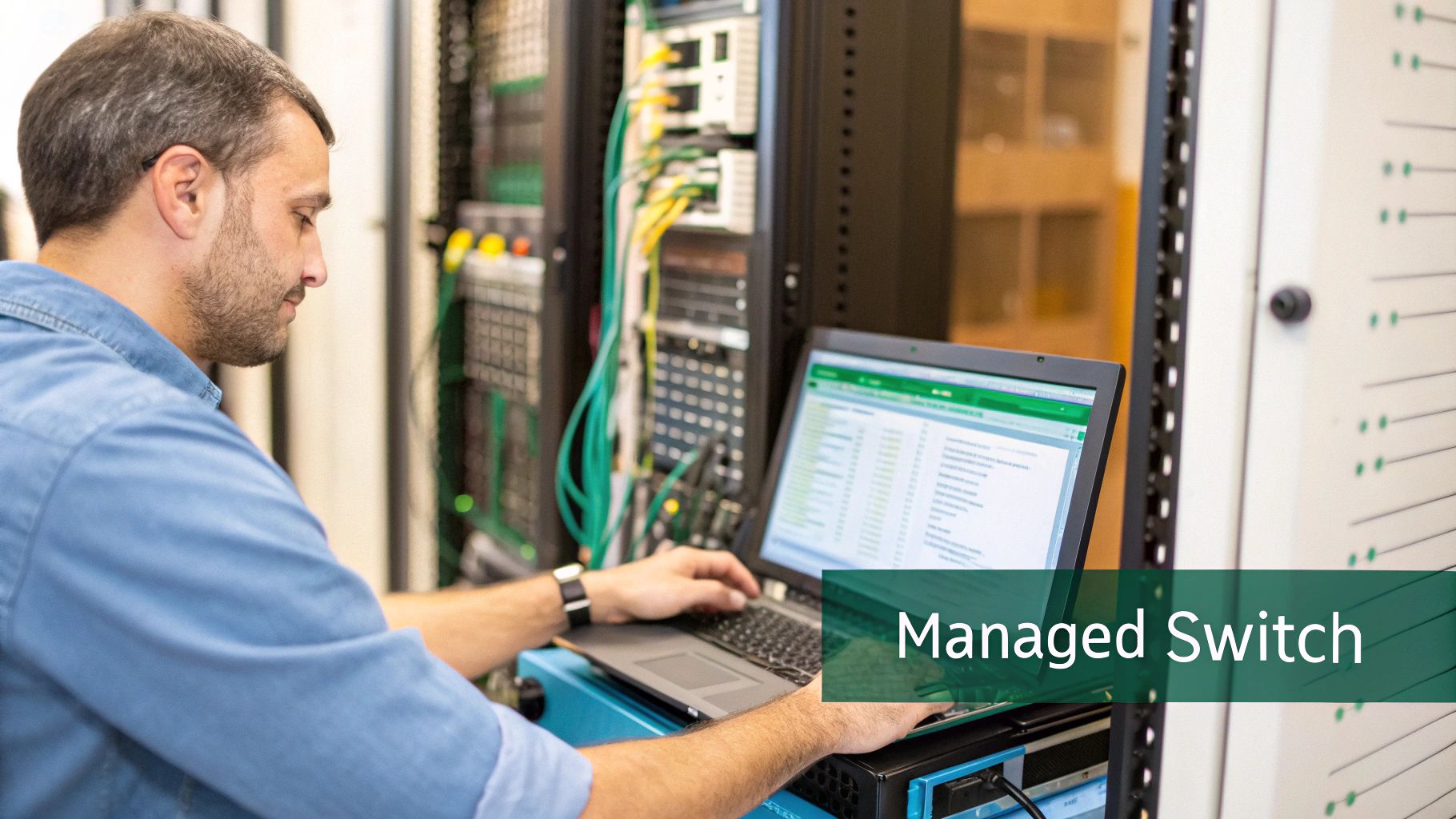Hey there! When you're trying to choose between a managed vs unmanaged switch, it really boils down to one simple question: how much control do you actually need over your network?
Think of an unmanaged switch as a simple plug-and-play device. It's built for basic connectivity, and that’s about it. A managed switch, on the other hand, is like getting the keys to the kingdom—it gives you the powerful, fine-grained control that modern business networks absolutely demand.
Understanding the Core Differences
Picking the right network hardware is a huge decision. While both types of switches connect devices on a network, their capabilities are worlds apart. An unmanaged switch is a straightforward, "what you see is what you get" device. It does one job: expanding your network ports with zero configuration needed. It's kind of like a power strip for your Ethernet connections—simple, effective, and perfect for a small home or office setup.
A managed switch is an entirely different beast. It's an intelligent device that acts as the central nervous system for any serious network. This is especially true in places like Education campuses, Retail stores, or corporate offices where BYOD (Bring Your Own Device) policies are the norm. These switches put IT administrators firmly in the driver's seat.
Managed vs Unmanaged Switch At a Glance
This quick comparison table should help you see the fundamental differences at a glance, making it easier to figure out what your network needs.
| Feature | Unmanaged Switch | Managed Switch |
|---|---|---|
| Configuration | Plug-and-Play (Zero Config) | Fully configurable via web UI, CLI, or cloud |
| Security | Basic/None | Advanced (VLANs, ACLs, Port Security) |
| Performance | Standard (First-Come, First-Served) | Traffic Prioritization (QoS) |
| Monitoring | No visibility | Comprehensive monitoring and analytics |
| Best For | Small home/office, simple networks | Businesses, large networks, complex needs |
| Cost | Low | Higher |
As you can see, the choice is a trade-off: do you want simplicity and low cost, or robust capability and total control?
Why Control Matters for Modern Networks
This enhanced control is exactly what makes advanced network solutions possible. Take a Cisco Meraki managed switch, for example. It serves as the backbone for creating secure Captive Portals. These portals are absolutely essential for managing guest access, a process you can explore further when you set up guest Wi-Fi.
Managed switches also support sophisticated authentication solutions like IPSK or EasyPSK. These are critical for securing every single device in a busy BYOD Corporate or Education environment where you have countless personal and company-owned devices connecting.
Ultimately, the kind of seamless, secure, and branded WiFi experience you see here is only achievable with the visibility and control you get from a managed switch. It’s all about building a network that doesn't just work, but works intelligently for your business.
The Simplicity of an Unmanaged Switch
Let’s chat about the unmanaged switch. Its biggest selling point is sheer simplicity. You take it out of the box, plug it in, connect your devices, and it just works. There’s no software to install, no confusing configuration screen to navigate, and definitely no need to call in an IT expert.
This plug-and-play design makes it a fantastic, low-cost option for very specific situations. It operates on a fixed, built-in logic that directs traffic based on device MAC addresses—nothing more, nothing less. This makes it perfect for small, isolated networks where all you really need are a few extra Ethernet ports.
When Simple is All You Need
So, where does an unmanaged switch really shine? I’ve seen them work perfectly in a few common scenarios:
- Home Offices: Ideal for connecting your desktop, a printer, and maybe a network-attached storage (NAS) drive.
- Small Retail Kiosks: Great for linking a single point-of-sale terminal to a credit card reader.
- Temporary Setups: Perfect for quickly networking a handful of laptops in a small conference room for a one-off event.
But this simplicity has its price. With an unmanaged switch, you get zero visibility into what’s happening on your network. There are no security features to speak of, and you have no way to prioritize or control traffic. This means you can't segment your network for guests or enforce the kind of security policies required in a corporate BYOD environment.
At its core, an unmanaged switch is all about providing basic connectivity with zero management overhead. Think of it as an extension cord for your network, not a control panel. This distinction is critical.
This lack of control is a total dealbreaker for anything beyond the most basic setups. For example, you can't run a Captive Portal for guest WiFi or use advanced authentication solutions like IPSK or EasyPSK with an unmanaged switch. Those features demand the intelligence of a managed device.
While unmanaged switches can give you more ports, they simply can't support the advanced features that modern enterprise WiFi access points rely on for security and a good user experience. For any growing business in sectors like Education or Retail that needs scalability and serious security, that "set-it-and-forget-it" approach quickly becomes a major liability, making a Cisco Meraki managed solution the logical next step.
Unlocking Network Control with a Managed Switch
When your network outgrows the simple "plug-and-play" functionality of an unmanaged switch, it’s time to level up. A managed switch is the central nervous system for any serious Education, Retail, or business network. It goes far beyond basic connectivity, giving you deep, granular control over every aspect of your network's traffic and performance.
With a managed switch, you're in the driver's seat. You can actively monitor performance, carve out secure Virtual LANs (VLANs) to isolate traffic, and give critical data the priority it deserves. This ensures that essential operations—like point-of-sale transactions or crucial video calls—always have the bandwidth they need, unaffected by less important network activity. This level of control is fundamental for building a secure and efficient network.
The Power of Granular Management
This fine-tuned control is precisely what allows you to deploy robust guest Wi-Fi with Captive Portals and integrate modern authentication solutions like IPSK and EasyPSK. For any organization juggling a BYOD policy, these features aren't just nice to have; they're essential for securing every device that connects. It's no wonder that managed switches are the fastest-growing segment of the Ethernet switching market. As network demands grow, so does the need for better performance and security. You can explore the research behind this market growth to see the data for yourself.
For instance, just take a look at the kind of detailed visibility a managed switch gives you.
This dashboard view shows how an administrator can visually monitor and configure the network. This just isn't possible with an unmanaged switch. Seeing traffic patterns and device health in real time means you can solve problems before they start and continuously optimize your network.
A managed switch transforms your network from a simple, passive utility into an active, intelligent asset. This is the key difference when discussing managed vs unmanaged switch capabilities for any growing business.
Enabling Advanced Solutions with Cisco Meraki
Platforms like Cisco Meraki are built to unlock the full potential of managed switches. They offer intuitive, cloud-based dashboards that make even complex network configurations surprisingly straightforward. Pairing a managed switch with a solution like Meraki helps organizations build a secure, reliable, and high-performing network infrastructure.
This combination is a perfect fit for a variety of environments:
- Corporate Offices: Easily manage and secure employee and guest devices under a comprehensive BYOD policy.
- Education Campuses: Create distinct, secure networks for students, faculty, and administrative staff using VLANs.
- Retail Stores: Prioritize payment systems for reliability while offering a branded guest Wi-Fi experience via a Captive Portal.
Ultimately, choosing a managed switch is about preparing your network for the future. It delivers the security, scalability, and control required to handle the demands of a modern organization, ensuring your network can grow and adapt right alongside your business.
When you're trying to decide between a managed vs unmanaged switch, the choice really boils down to three things: security, performance, and cost. On the surface, they might just look like boxes with a bunch of ports, but what’s inside creates a world of difference for your network, especially in places like Retail stores, Education campuses, or offices that have BYOD policies.
Think of an unmanaged switch as an open door. It's a simple plug-and-play device with zero built-in security. Any device that gets plugged in has instant, unrestricted access to your entire network. For a tiny, isolated home office, that might be okay. But for any business that cares about its data, it’s a massive vulnerability. You get no ability to set up a Captive Portal or implement any real authentication solutions.
The Security Fortress of a Managed Switch
This is where a managed switch, particularly from a platform like Cisco Meraki, truly shines. It’s not just a switch; it's a security powerhouse. It gives you the tools to build a digital fortress around your network with features that are completely absent in unmanaged models. This is where you can start implementing serious, enterprise-grade security.
You can create granular policies to dictate exactly who and what can connect. For example, you could use port security to lock down a physical port to a specific device or use Access Control Lists (ACLs) to filter traffic based on rules you define. This level of control is absolutely essential for deploying robust authentication methods like IPSK and EasyPSK. These protocols give each user and device a unique key, which dramatically tightens security in a BYOD environment. Getting a handle on these different security approaches is key; we break it down further in our guide comparing WPA2 Personal vs Enterprise.
The infographic below really helps visualize these core differences, contrasting the levels of control, features, and cost.
As you can see, a managed switch offers a much higher degree of control and a richer feature set. This explains its higher price point, but it also reflects its far greater value to a business.
Performance and Long-Term Cost
Performance is another critical battleground. An unmanaged switch is a free-for-all; it treats all network traffic the same. This means one person’s massive file download can bring your critical business applications to a grinding halt.
A managed switch changes the game with Quality of Service (QoS). This feature lets you prioritize certain types of traffic, ensuring your VoIP calls, video conferences, and point-of-sale systems always have the bandwidth they need to run flawlessly.
When you weigh the options of a managed vs unmanaged switch, remember that cost is more than just the sticker price. It's about the long-term value of security, reliability, and business continuity.
The upfront cost of a managed switch is higher, there's no denying it. But it's an investment in the health and security of your entire operation. The potential cost of a single security breach or a day of network downtime will almost certainly eclipse whatever you saved by opting for a cheaper, unmanaged device.
Real-World Scenarios: Education, Retail, and Corporate
Theory is one thing, but seeing how the choice between a managed and an unmanaged switch plays out in the real world is what really makes the decision click. Let's walk through a few common environments to see why a managed switch is often less about the hardware itself and more about being a critical business tool.
As networks get more crowded and complex, this choice becomes even more important. The global switch market is expanding, and a huge part of that growth is driven by cloud services and the explosion of IoT devices—all demanding reliable and secure connections. In this landscape, the control and visibility offered by managed switches are quickly becoming the standard, not the exception.
The Modern Education Campus
Picture a bustling university campus. You have students in dorms streaming lectures, faculty in offices accessing research databases, and administrative staff handling highly sensitive information. In the Education sector, an unmanaged switch would lump all that traffic into one chaotic, unsecured digital free-for-all. It's a security nightmare waiting to happen.
This is where a managed switch, especially a device from a platform like Cisco Meraki, proves its worth. It gives IT administrators the power to create separate, secure networks using VLANs (Virtual Local Area Networks). In practice, this means student traffic on the "Dorm-WiFi" network is completely walled off from the faculty network, which is also isolated from the administrative network handling student records and financial data. This segmentation is a fundamental security practice.
The scene below of a student using Wi-Fi on campus is an everyday occurrence, but it’s the managed network running silently in the background that makes it secure and reliable.
This seamless experience depends entirely on a managed switch to authenticate users via a Captive Portal and intelligently direct traffic, preventing the entire network from grinding to a halt during peak usage times like final exams.
The Dynamic Retail Environment
Now, let's step into a busy Retail store. The network here has to juggle several critical jobs at once. You have point-of-sale (POS) terminals processing payments, inventory scanners connecting to the stockroom database, and of course, guest Wi-Fi for shoppers.
A managed switch allows the store to prioritize its traffic. It can be configured to guarantee that credit card transactions always have the bandwidth they need to go through instantly, even if dozens of shoppers are streaming videos on the guest network. For any retail business, that kind of reliability is non-negotiable.
In retail, a managed switch isn't just about connectivity; it’s about customer experience and revenue protection. A branded Captive Portal for guest Wi-Fi and prioritized payment traffic are only possible with a managed device.
This level of control also opens the door for creating better guest experiences. With a managed network, a retailer can use a Captive Portal through a provider like Splash Access, which does more than just offer secure Wi-Fi. It can also present customers with special offers or invite them to join a loyalty program, turning a simple amenity into a powerful marketing tool.
The Secure BYOD Corporate Sector
In the modern BYOD Corporate world, "Bring Your Own Device" policies are now standard practice. While convenient, this introduces a major security challenge: how do you let employees connect with their personal phones and laptops without exposing the corporate network to potential threats?
A managed switch is the cornerstone of a solid security strategy here. It supports advanced authentication solutions like IPSK (Identity Pre-Shared Key) or EasyPSK. These systems allow an IT department to assign a unique, private password to every single device, providing granular control over network access. If an employee leaves the company, their access can be revoked in seconds without disrupting anyone else. To get a better handle on the latest in wireless security, you can check out https://splashaccess.com/what-is-wpa-3/ and see how it builds on these core principles.
In each of these environments—Education, Retail, and Corporate—an unmanaged switch would be a serious liability. The control, security, and performance you get from a managed switch are simply essential for meeting the demands of today's business operations.
Making the Right Choice for Your Network
So, after digging into all the details of managed vs unmanaged switches, it all comes down to a single question: which one is right for your network? There's no single correct answer, but the right choice always comes from a clear-eyed assessment of your needs today and where you see them heading tomorrow.
For a straightforward home network or a tiny office—I’m talking fewer than 10-15 devices and no real security worries—an unmanaged switch is a solid, no-frills choice. It's plug-and-play, affordable, and gets the job done. But the second your needs start to evolve, the conversation shifts dramatically.
When to Invest in a Managed Switch
If your business is growing, you're handling sensitive customer or company data, or you rely on applications that absolutely must stay online, a managed switch stops being a luxury and becomes a necessity. It’s the bedrock of any modern, professional, and secure network.
Think about the last time you seamlessly connected to public Wi-Fi at a coffee shop or airport.
That kind of simple, secure experience doesn't just happen by accident. It's the direct result of a managed network infrastructure working hard behind the scenes, especially in demanding Retail, Education, or BYOD Corporate environments.
For any organization planning to deploy a network with features like Captive Portals and advanced authentication solutions, a managed switch isn't just a good idea—it's an absolute necessity.
This is where platforms from industry leaders like Cisco Meraki really shine. They are built to handle sophisticated tasks like secure guest Wi-Fi, managing BYOD policies with tools like IPSK and EasyPSK, and ensuring your network remains robust. When you’re thinking about your needs, don't forget how the network backbone affects other critical services. Your choice of switch can make or break the performance of things like small business VoIP solutions, where clear, uninterrupted communication is key.
Ultimately, choosing a managed switch is an investment in your network's future. It opens the door to advanced features that seriously level up both your security and the experience you provide to users. To get a glimpse of where connectivity is headed, take a look at our guide on what Passpoint WiFi is and how it’s making secure access even more seamless.
Frequently Asked Questions
Still weighing your options between a managed vs. unmanaged switch? Let's tackle some of the most common questions we hear. This should help you land on the right choice for your specific network, whether it's for your home or business.
Can I Use a Managed Switch at Home?
Absolutely! While a simple unmanaged switch gets the job done for most homes, a managed switch is a huge step up for power users. If you're a serious gamer, work remotely with specific security requirements, or just love to tinker, the control you get is well worth it.
Imagine prioritizing your work video calls over your kids' streaming service or setting up a completely separate, walled-off network for all your smart home gadgets. For anyone running a home-based business or a sophisticated smart home, especially with gear from Cisco Meraki, the granular control a managed switch offers is a real game-changer.
Do I Need IT Skills for a Managed Switch?
Not nearly as much as you used to. In the past, managing a switch meant staring at a command-line interface, which was understandably intimidating for most people. Today, things are much, much friendlier.
Modern managed switches, particularly those from brands like Cisco Meraki, are often configured through intuitive, web-based dashboards. This visual approach makes complex tasks far more accessible, so you don't need to be a network engineer to get things running.
A managed switch is non-negotiable for creating a truly secure guest network. It’s the only way to build a separate Virtual LAN (VLAN) that completely isolates guest traffic from your sensitive internal network.
Once you've set up that guest VLAN, you can then point it toward a Captive Portal for authentication. This is how you give visitors a professional, branded Wi-Fi login experience without them ever getting close to your company data. It’s a foundational security step for Retail, Education, and any corporate BYOD environment and opens the door for advanced authentication solutions like IPSK and EasyPSK.
Ready to provide a secure, branded, and data-driven Wi-Fi experience for your guests and users? Discover how Splash Access can elevate your network by visiting us at https://www.splashaccess.com to learn more.







